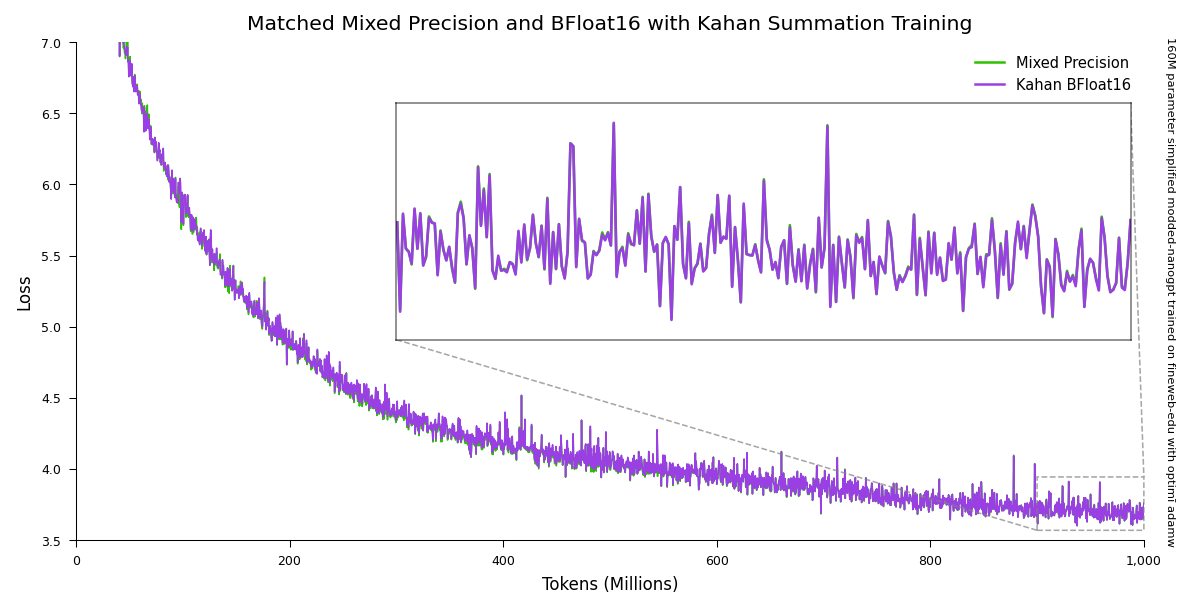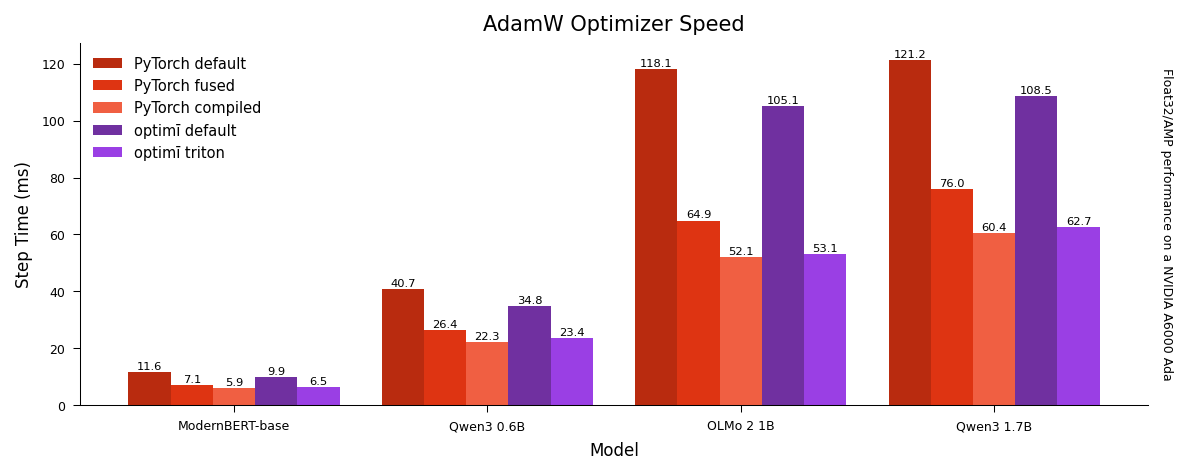optimī¶
Fast, Modern, and Low Precision PyTorch Optimizers
optimi enables accurate low precision training via Kahan summation, integrates gradient release and optimizer accumulation for additional memory efficiency, supports fully decoupled weight decay, and features fast implementations of modern optimizers.
Low Precision Training with Kahan Summation¶
optimi optimizers can match the performance of mixed precision when training in pure BFloat16 by using Kahan summation.

Training in pure BFloat16 with Kahan summation can reduce non-activation training memory usage up to 37 to 45 percent when using an Adam optimizer. BFloat16 training can increase single GPU training speed up to 10 percent at the same batch size.
Fast Triton Implementations¶
optimi's fused Triton optimizers are faster than PyTorch's fused Cuda optimizers, and nearly as fast as compiled optimizers without any hassle.

optimi's Triton backend supports modern NVIDIA (Ampere or newer), AMD, and Intel GPUs, and is enabled by default for all optimizers.
Fully Decoupled Weight Decay¶
In addition to supporting PyTorch-style decoupled weight decay, optimi optimizers also support fully decoupled weight decay.
Fully decoupled weight decay decouples weight decay from the learning rate, more accurately following Decoupled Weight Decay Regularization. This can help simplify hyperparameter tuning as the optimal weight decay is no longer tied to the learning rate.
Gradient Release: Fused Backward and Optimizer Step¶
optimi optimizers can perform the optimization step layer-by-layer during the backward pass, immediately freeing gradient memory.
Unlike the current PyTorch implementation, optimi’s gradient release optimizers are a drop-in replacement for standard optimizers and seamlessly work with exisiting hyperparmeter schedulers.
Optimizer Accumulation: Gradient Release and Accumulation¶
optimi optimizers can approximate gradient accumulation with gradient release by accumulating gradients into the optimizer states.
Optimizers¶
optimi implements the following optimizers:
Install¶
optimi is available to install from pypi.
pip install torch-optimi
Usage¶
To use an optimi optimizer with Kahan summation and fully decoupled weight decay:
import torch
from torch import nn
from optimi import AdamW
# create or cast model in low precision (bfloat16)
model = nn.Linear(20, 1, dtype=torch.bfloat16)
# initialize any optimi optimizer with parameters & fully decoupled weight decay
# Kahan summation is automatically enabled since model & inputs are bfloat16
opt = AdamW(model.parameters(), lr=1e-3, weight_decay=1e-5, decouple_lr=True)
# forward and backward, casting input to bfloat16 if needed
loss = model(torch.randn(20, dtype=torch.bfloat16))
loss.backward()
# optimizer step
opt.step()
opt.zero_grad()
To use with PyTorch-style weight decay with float32 or mixed precision:
# create model
model = nn.Linear(20, 1)
# initialize any optimi optimizer with parameters
opt = AdamW(model.parameters(), lr=1e-3, weight_decay=1e-2)
To use with gradient release:
# initialize any optimi optimizer with `gradient_release=True`
# and call `prepare_for_gradient_release` on model and optimizer
opt = AdamW(model.parameters(), lr=1e-3, gradient_release=True)
prepare_for_gradient_release(model, opt)
# setup a learning rate scheduler like normal
scheduler = CosineAnnealingLR(opt, ...)
# calling backward on the model will peform the optimzier step
loss = model(torch.randn(20, dtype=torch.bfloat16))
loss.backward()
# optimizer step and zero_grad are no longer needed, and will
# harmlessly no-op if called by an existing training framework
# opt.step()
# opt.zero_grad()
# step the learning rate scheduler like normal
scheduler.step()
# optionally remove gradient release hooks when done training
remove_gradient_release(model)
To use with optimizer accumulation:
# initialize any optimi optimizer with `gradient_release=True`
# and call `prepare_for_gradient_release` on model and optimizer
opt = AdamW(model.parameters(), lr=1e-3, gradient_release=True)
prepare_for_gradient_release(model, opt)
# update model parameters every four steps after accumulating
# gradients directly into the optimizer states
accumulation_steps = 4
# setup a learning rate scheduler for gradient accumulation
scheduler = CosineAnnealingLR(opt, ...)
# use existing PyTorch dataloader
for idx, batch in enumerate(dataloader):
# `optimizer_accumulation=True` accumulates gradients into
# optimizer states. set `optimizer_accumulation=False` to
# update parameters by performing a full gradient release step
opt.optimizer_accumulation = (idx+1) % accumulation_steps != 0
# calling backward on the model will peform the optimizer step
# either accumulating gradients or updating model parameters
loss = model(batch)
loss.backward()
# optimizer step and zero_grad are no longer needed, and will
# harmlessly no-op if called by an existing training framework
# opt.step()
# opt.zero_grad()
# step the learning rate scheduler after accumulating gradients
if not opt.optimizer_accumulation:
scheduler.step()
# optionally remove gradient release hooks when done training
remove_gradient_release(model)
Differences from PyTorch¶
optimi optimizers do not support compilation, differentiation, complex numbers, or have capturable versions.
optimi Adam optimizers do not support AMSGrad and SGD does not support Nesterov momentum. Optimizers which debias updates (Adam optimizers and Adan) calculate the debias term per parameter group, not per parameter.